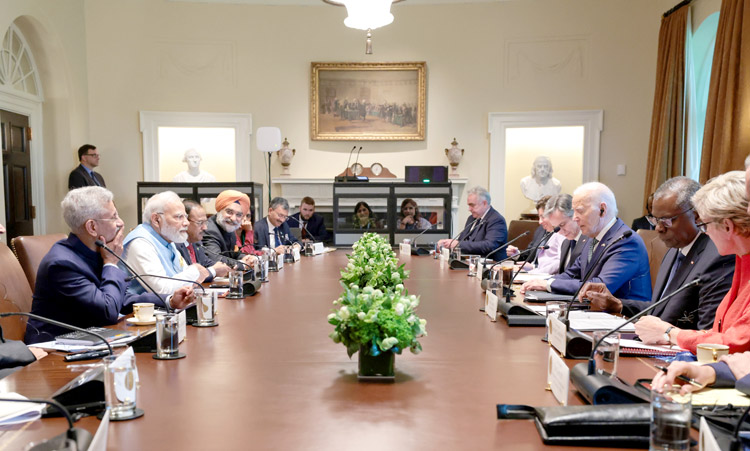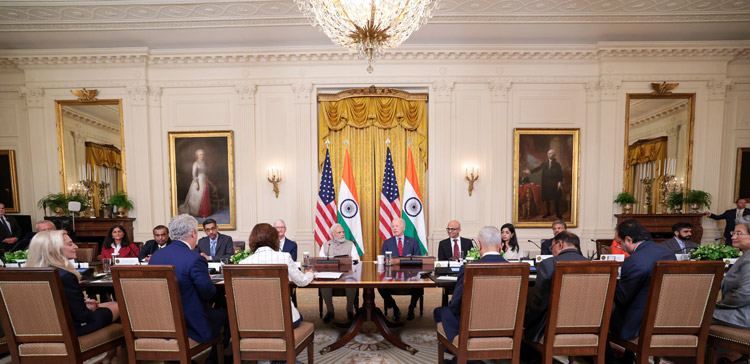Prime Minister Modi’s Visit to the US boosts Bilateral Engagement in Defence, Space, and Technology building a Stronger Alliance and ushering in a New Era of Mutual Cooperation

PRIME MINISTER NARENDRA MODI MEETS THE US PRESIDENT JOE BIDEN AT WHITE HOUSE IN WASHINGTON DC
Prime Minister Narendra Modi recently concluded his extensive visit to the United States. “Concluding an exceptional USA visit, where I got to take part in numerous programmes and interactions aimed at adding momentum to the India-USA friendship. Our nations will keep working together to make our planet a better place for the coming generations,” he tweeted on June 24, 2023. The visit witnessed a lot of key developments, deliberations, and meetings in the fields of defence, education, environment, technology, and other global affairs.
In his opening statement at the bilateral meeting with the US President, Prime Minister Modi said, “Today, India and America are walking shoulder to shoulder in every front from the heights of space to the depths of the ocean, from ancient culture to artificial intelligence. When it comes to relations between any two countries from a diplomatic point of view, it is usually about formal joint statements, working groups, and MoUs. Indeed, it has its own importance but the real engine carrying forward the relationship between India and America is our strong people-topeople relationship. And we heard a loud roar of this engine just outside on the lawn of the White House.”
He continued, “When I first visited the US as Prime Minister, India was the tenth-largest economy in the world. Today, India is the fifth largest economy. And, India will be the third-largest economy soon. We are not only growing bigger but we are also growing faster. When India grows, the whole world grows. After all, we are one-sixth of the world’s population! The close defence cooperation between India and America symbolises mutual trust and shared strategic priorities. Moving away from the old buyer-seller relationship we had earlier, we have transitioned today to a relationship involving the transfer of technology, co-development, and coproduction.”

PRIME MINISTER NARENDRA MODI AND THE PRESIDENT OF USA, JOE BIDEN AT THE EXPANDED BILATERAL MEETING IN WHITE HOUSE, WASHINGTON DC
Some of the key highlights from Indian Prime Minister’s Official State Visit to the United States included:
NEXT-GENERATION DEFENSE PARTNERSHIP
General Atomics MQ-9Bs: India intends to procure armed MQ-9B SeaGuardian UAVs. This advanced technology will increase India’s intelligence, surveillance, and reconnaissance capabilities.
New Sustainment and Ship Repair: The United States Navy has concluded a Master Ship Repair Agreement (MSRA) with Larsen and Toubro Shipyard in Kattupalli (Chennai) and is finalising agreements with Mazagon Dock Limited (Mumbai) and Goa Shipyard (Goa). These agreements will allow mid-voyage US Navy ships to undergo service and repair at Indian shipyards, facilitating cost-effective and time-saving sustainment activities for US military operations across multiple theaters.
More Robust Defence Cooperation: The United States and India resolved to strengthen undersea domain awareness cooperation. The agreement to place three Indian liaison officers in US commands for the first time– deepening the partnership and critical information sharing. US and India have also commenced negotiations for a Security of Supply Arrangement and Reciprocal Defence Procurement Arrangement that will enable the supply of defence goods in the event of unanticipated supply chain disruptions. The two countries finalised a Defence Industrial Cooperation Roadmap that provides policy direction to defence industries and enables the co-production of advanced defence systems as well as collaborative research, testing, and prototyping of the technologies that will determine the future of military power.
India joins 26 other nations in signing the Artemis Accords, advancing peaceful and sustainable space exploration
Defence “Innovation Bridge”: The India-US Defence Acceleration Ecosystem (INDUS-X)—a network of universities, incubators, corporate, think tanks, and private investment stakeholders—was inaugurated on June 21, 2023. This innovative programme will facilitate joint innovation on defence technologies and accelerate the integration of India’s budding private sector defence industry with the US defence sector.
Defence Industrial Cooperation Roadmap: A new defence industrial cooperation roadmap will provide policy direction to defence industries to enable and accelerate the co-production of advanced defence systems as well as collaborative research, testing, and prototyping of the technologies that will determine the future of military power.

PRIME MINISTER NARENDRA MODI ADDRESSING THE JOINT SESSION OF US CONGRESS, IN WASHINGTON DC ON JUNE 22, 2023
“When defence and aerospace in India grow, industries in the states of Washington, Arizona, Georgia, Alabama, South Carolina, and Pennsylvania thrive. When American companies grow, their research and development centers in India thrive. When Indians fly more, a single order for aircraft creates more than a million jobs in forty-four states in America,” President Biden added.
“We have also decided that amidst global uncertainties, India and the US, as trusted partners, will create reliable, secure, and resilient global supply chains and value chains. The close defence cooperation between India and the United States is a symbol of our mutual trust and shared strategic priorities. Leaving behind the old buyer-seller relationship, today we have moved towards the transfer of technology, co-development, and co-production”, added Prime Minister Modi.
“EVEN SKY IS NOT THE LIMIT”
During this visit, an important highlight was the coming together of both nations to explore the new frontiers in Space. India has signed the much talked about Artemis Accords, which advance a common vision of space exploration for the benefit of all humankind. Having signed it, India has joined 26 other countries committed to peaceful, sustainable, and transparent cooperation that will enable exploration of the Moon, Mars, and beyond. The Artemis Accords establish a practical set of principles to guide space exploration cooperation among nations, including those participating in NASA’s Artemis programme. During a ceremony at the Willard InterContinental Hotel in Washington, NASA Administrator Bill Nelson participated in the signing ceremony for the agency and Taranjit Singh Sandhu, India’s Ambassador to the United States, signed on behalf of India.
India and the US establish joint research initiatives in quantum, AI, and advanced wireless technologies, paving the way for groundbreaking collaboration in cutting-edge research
NASA will also provide advanced training to Indian Space Research Organisation (ISRO) astronauts with the goal of launching a joint effort to the International Space Station (ISS) in 2024. Additionally, NASA and the ISRO are developing a strategic framework for human spaceflight cooperation by the end of 2023. India approved a $318 million investment to construct a Laser Interferometer Gravitational-Wave Observatory in India—that will work in tandem with similar facilities in the United States, Europe, and Japan to look for ripples in space-time, known as gravitational waves, that provide insights into the physical origins of the universe. Scientific payloads for the NASA-ISRO Synthetic Aperture Radar (NISAR) have been delivered to India and will be launched in 2024, and will measure Earth’s changing ecosystems like natural hazards and sea level rise. The US Geological Survey and ISRO are negotiating expanded bilateral data exchange that will enable greater insight into the earth, including for a range of applications, such as climate resiliency, sustainable development and management of natural resources, and disaster management support.

PRIME MINISTER NARENDRA MODI AND THE PRESIDENT OF USA, JOE BIDEN DURING THE MEETING WITH TOP CEOS AT WHITE HOUSE, WASHINGTON DC
During the visit, the Prime Minister even met SpaceX CEO, Elon Musk, inviting him to explore opportunities in India for investments in electric mobility and the rapidly expanding commercial space sector. Musk expressed his admiration for the Prime Minister and indicated his plans to visit India next year.
MORE TECHNOLOGY PARTNERSHIPS FOR THE FUTURE
Quantum, Advanced Computing, and Artificial Intelligence: India and the United States have established a Joint Indo-US Quantum Coordination Mechanism to facilitate joint research between the public and private sectors across both our countries. The United States also welcomed India’s participation in both the Quantum Entanglement Exchange and the Quantum Economic Development Consortium, which facilitates exchanges on the quantum between nations. Additionally, India and the United States signed an implanting arrangement to further support joint research on quantum, Artificial Intelligence (AI), and advanced wireless technologies—building off of the US-India Science and Technology Endowment Fund’s $2 million grant for the joint development and commercialisation of Artificial Intelligence and quantum technologies.
Cutting-edge Research: The US National Science Foundation announced 35 joint research collaborations with the Indian Department of Science and Technology and also signed a new cooperative arrangement with the Indian Ministry of Electronics and Information Technology on emerging technologies. India’s Department of Atomic Energy (DAE) is making a $140 million in-kind contribution to the US Department of Energy’s (DOE’s) Fermi National Laboratory.
Strengthening Semiconductor Supply Chains: Micron Technology – with support from the India Semiconductor Mission – will invest more than $800 million toward a new $2.75 billion semiconductor assembly and test facility in India. Applied Materials has announced it will build a Semiconductor Centre for Commercialisation and Innovation in India to further strengthen the semiconductor supply chain diversification. And, Lam Research will train 60,000 Indian engineers through its “Semiverse Solution” to accelerate India’s semiconductor education and workforce development goals.
Advanced Telecommunications: India and the United States launched public-private Joint Task Forces, one on the development and deployment of Open RAN systems and one on advanced telecoms research and development. India’s Bharat 6G and the US Next G Alliance will co-lead this public-private research. This work will reduce costs, increase security, and improve the resiliency of telecommunication networks. With financing from the US International Development Finance Corporation, and in partnership with USAID, India and the United States are also teaming up to launch Open RAN deployments in both countries to demonstrate the scalability of this technology to enhance its competitiveness in international markets. The leaders also welcomed participation of Indian companies in the US Rip and Replace Program.
“And with this visit, we’re demonstrating once more how India and the United States are collaborating on nearly every human endeavor and delivering progress across the board, for — from designing new ways to diagnose and treat illnesses like cancer and diabetes; to collaborating on human spaceflight including sending an Indian astronaut to the International Space Station in 2024; to accelerating the global clean energy transition and tackling climate — the climate crisis we face; to harnessing our shared expertise on critical and emerging technologies like quantum computing and artificial intelligence to ensuring they are not used as tools of misinformation and oppression,” President Biden stated.
In his remarks, Modi further underlined the immense potential of harnessing India-US tech cooperation for socioeconomic growth. He also applauded the contribution of India’s talented youth in fostering a culture of innovation. President Biden called on CEOs to help expand India-US tech partnerships to new fields including biotechnology and quantum. Both leaders underscored that the India-US partnership would play an instrumental role in building a better future for our people and for the world.












